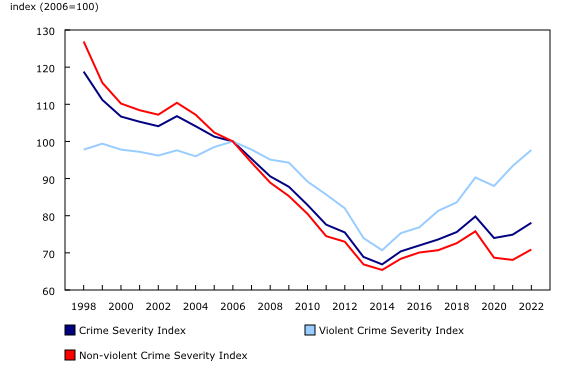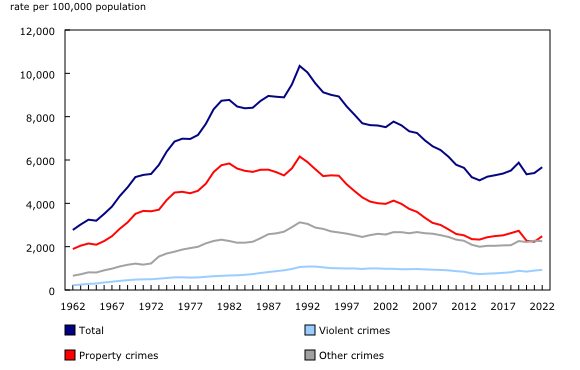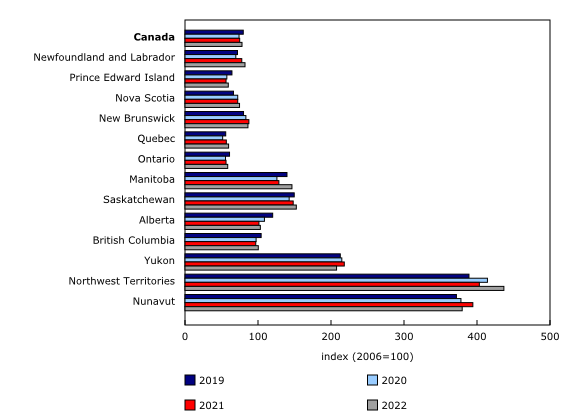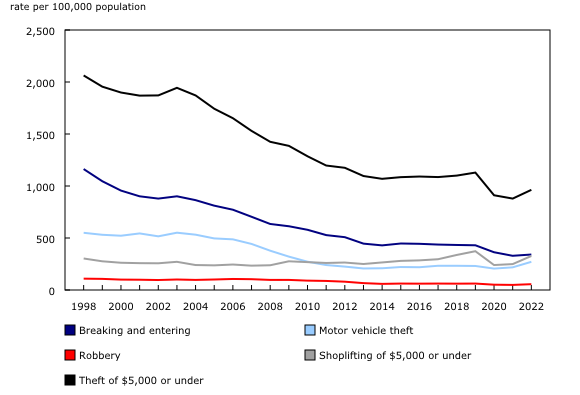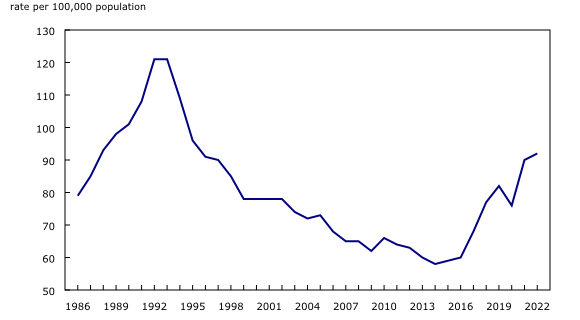Police-reported crime statistics in Canada, 2022
Released: 2023-07-27
Police-reported crime in Canada, as measured by the Crime Severity Index (CSI), increased for the second consecutive year, up 4% in 2022. The Violent CSI rose in 2022, reaching its highest point since 2007. The Non-violent CSI also increased in 2022 but remained lower than before the start of the COVID-19 pandemic.
The consecutive increases recorded in the overall CSI may indicate a return to the upward trend in crime observed before the start of the pandemic. The first year of the pandemic was marked by a decline in the overall volume and severity of police-reported crime, notably while lockdown restrictions were first implemented, driven by less non-violent crime. Before this drop, the CSI had been rising for five consecutive years beginning in 2015 (+19% over five years).
The Violent CSI rose 5% in 2022, following a 6% increase the previous year. Compared with 2021, the increase in the Violent CSI in 2022 included higher rates of robbery (+15%), extortion (+39%), homicide (+8%) and level 1 sexual assault (+3%).
The Non-violent CSI—which includes, for example, property offences and drug offences—rose 4% in 2022 but was 6% lower than in 2019. Much of the increase in 2022 was because of higher rates of several property crimes, notably motor vehicle theft (+24%), breaking and entering (+4%), minor theft ($5,000 or under; +10%), shoplifting ($5,000 or under; +31%) and general fraud (+7%). In contrast, rates of other non-violent violations, such as drug offences (-17%), identity fraud (-11%) and identity theft (-8%), impaired driving (-3%) and administration of justice violations (-2%), were down from 2021.
The CSI takes into account both the volume and the severity of crime. The police-reported crime rate—a measure of the volume of crime—increased by 5% from 2021 to 2022, up to 5,668 incidents per 100,000 population. Like the CSI, the crime rate in 2022 (-4%) was lower than in 2019.
Interactive data visualization dashboards for police-reported crime statistics are now available through the "Police-reported Information Hub." The accompanying infographic "Police-reported crime in Canada, 2022" is also now available.
Detailed tables with police-reported information by violation and geography (province, territory and census metropolitan area) are available at the end of this article.
For a technical summary about the collection and dissemination of police-reported crime data, see last year's article "Police-reported crime statistics in Canada, 2021" and the Juristat publication.
Crime Severity Index rises for most of Canada
Most provinces and territories recorded increases in the CSI from 2021 to 2022, with the exceptions of New Brunswick (-2%), Yukon (-5%) and Nunavut (-4%).
Among the provinces, Manitoba (+14%) recorded the largest CSI increase in 2022, with violent and non-violent crime contributing fairly equally to the change. This was followed by Newfoundland and Labrador, Quebec and Prince Edward Island, which all increased by 6%.
Rates of theft, breaking and entering, and robbery increase but remain generally lower than before the pandemic
Rates of theft (the combined rate of motor vehicle theft, major and minor theft and shoplifting of $5,000 or under), breaking and entering and robbery increased in 2022, after declining during the start of the pandemic in 2020. Motor vehicle theft had the greatest impact on the increase in the overall CSI in 2022, followed by robbery, breaking and entering, minor theft and shoplifting.
More specifically, rates of shoplifting (+31%), minor theft (+10%) and breaking and entering (+4%) increased in 2022 yet remained lower than in 2019. The rate of motor vehicle theft (+24%) also increased in 2022 and was 17% higher than in 2019. Breaking and entering, the most severe type of property crime according to the CSI, continued to be one of the more common crimes. In 2022, nearly 133,000 incidents were reported by police, contributing 16% to the CSI, the most of any violation.
The rate of robbery was also up for the first time in two years, increasing 15% in 2022. Despite the increase, the rate was 10% lower than in 2019. Over the five years preceding the drop in 2020, national robbery rates had remained relatively stable. Categorized as a violent violation, robbery accounted for 39% of the increase in the Violent CSI in 2022.
Rate of fraud nearly twice as high as a decade earlier, and extortion five times higher
In 2022, the rate of police-reported fraud (which includes general fraud, identity theft and identity fraud) was 78% higher than a decade earlier. Compared with 2021, fraud increased 4% to 459 incidents per 100,000 population in 2022 and, aside from two years of stability in 2020 and 2021, has generally been on the rise since 2011.
Extortion is a relatively serious violent crime that involves obtaining property through coercion and is often associated with fraud. The rate of police-reported extortion increased for the third consecutive year in 2022 (+39% to 25 incidents per 100,000 population), following similar increases in 2020 and 2021. Overall, the rate of extortion was five times higher in 2022 than in 2012, rising from 5 to 25 incidents per 100,000 population.
Relatively high proportions of fraud (23%) and extortion (48%) are reported as cybercrimes. Combined, these offences made up 62% of cybercrimes in 2022.
Smaller rise in police-reported hate crime after two sharp increases
Canada is ethnoculturally and religiously diverse, a characteristic of the country that is both legally protected and valued by most Canadians. Despite this, people living in Canada are not always treated equally, and many encounter various forms of discrimination and victimization. For example, according to data from the 2020 General Social Survey on Social Identity, just over one-third of the population aged 15 years or older reported having experienced discrimination at some point before or since the beginning of the pandemic.
Hate crimes are one specific example of discrimination, targeting the integral and visible parts of a person's identity and possibly affecting not only the individual but also the wider community. The number of police-reported hate crimes increased by 7%, from 3,355 incidents in 2021 to 3,576 incidents in 2022. This followed a 72% increase from 2019 to 2021. Higher numbers of hate crimes targeting a race or an ethnicity (+12%; 1,950 incidents) and a sexual orientation (+12%; 491 incidents) accounted for most of the increase. Hate crimes targeting a religion were down 15% in 2022, yet remained higher than the previous three years. Among the provinces and territories, Ontario, Nova Scotia and Saskatchewan accounted for much of the national increase.
National homicide rate increases for fourth consecutive year
Police reported 874 homicides in 2022, 78 more than the year before. The homicide rate increased 8% from 2.08 homicides per 100,000 population in 2021 to 2.25 homicides per 100,000 population in 2022. This was the highest rate since 1992. The national increase was largely the result of more homicides in British Columbia (+30 homicides), Manitoba (+26 homicides) and Quebec (+20 homicides). As has been the case historically, provincial homicide rates were highest in Manitoba (6.24 homicides per 100,000 population) and Saskatchewan (5.94 per 100,000).
The homicide rates in the Northwest Territories (6.58 homicides per 100,000 population), Yukon (4.57 per 100,000) and Nunavut (2.47 per 100,000) were above the national average in 2022. The relatively small population counts in the territories typically result in more variable annual rates.
Rates of homicide higher among Indigenous people and racialized people
Indigenous people are overrepresented among victims of violence in Canada, including victims of homicide. Several scholars have alluded to the association between violence against Indigenous people (First Nations people, Métis and Inuit) and the traumatic and destructive history of colonization and enduring marginalization that has impacted and continues to impact Indigenous families and communities (for more information, see the Note to readers).
Police reported 225 Indigenous homicide victims in 2022, 32 more than in 2021. Over two-thirds (69%) of Indigenous homicide victims were identified by police as First Nations, while 3% were identified as Métis and 4% as Inuk (Inuit). The specific Indigenous group was not identified by police for 24% of Indigenous homicide victims. The homicide rate for Indigenous people (10.98 homicides per 100,000 population) was nearly seven times higher than for the non-Indigenous population (1.69 homicides per 100,000 population).
There were 265 victims of homicide identified by police as racialized (a diverse grouping of those who are identified as belonging to one of the visible minority groups defined by the Employment Equity Act), accounting for almost one-third (31%) of homicide victims in 2022. The rate of homicide for the racialized population was higher than the previous year, up 2% from 2.45 homicides per 100,000 population in 2021 to 2.49 homicides per 100,000 population in 2022. This rate was higher than the rate in 2022 for the non-racialized and non-Indigenous population (2.12 homicides per 100,000 population). Two out of five (43%) racialized victims were identified by police as Black, and another 27% were identified as South Asian.
Rate of violent Criminal Code firearm offences up for eighth consecutive year, while non-violent firearm offences stable
Measuring the incidence of firearm offences is complex, because it includes a range of violent and non-violent offences. For example, they can include specific violent Criminal Code offences that involve firearms, such as discharging a firearm with intent, pointing a firearm or using a firearm in the commission of an indictable offence. These offences increased for the eighth consecutive year, rising 4% in 2022 to 12.2 incidents per 100,000 population. In contrast, non-violent Criminal Code offences that involve a firearm, such as illegal possession and unsafe storage, remained stable after increasing for seven years (52.5 incidents per 100,000 population in 2021 to 52.4 incidents per 100,000 population in 2022). The vast majority (92%) of these non-violent violations were related to possession of weapons offences and breach offences for weapons possession contrary to an order.
Furthermore, other firearm-related offences can include more serious violent crimes, such as homicide and robbery, that also involved a firearm in the commission of the offence. In 2022, there were 9,198 victims of violent crime where a firearm was present during the commission of the offence (30.8 victims per 100,000 population). This rate was 10% higher compared with 2021. The rate of victims of firearm-related crime has generally been increasing since 2013 (+60%).
More specifically, 4 in 10 (41%) homicides were firearm-related in 2022, similar to 2021 (40%). Of the 342 firearm-related homicides, 63% were committed with a handgun, and 23% were committed with a rifle or shotgun. The firearm type was unknown or of another type for the remaining 14% of firearm-related homicides.
Rise in the rate of level 1 sexual assault
The rate of police-reported level 1 sexual assault rose 3% to a rate of 90 incidents per 100,000 population in 2022, an increase of 1,574 incidents. With the exception of a decrease in 2020, the rate of level 1 sexual assault has been rising since 2014.
As in previous years, level 1 sexual assault accounted for 98% of sexual assaults in 2022. Rates of level 2 and level 3 sexual assault, two more serious offences, remained stable and both decreased 4%.
Note to readers
Uniform Crime Reporting Survey
Police-reported crime data, other than detailed information on homicides, are drawn from the Uniform Crime Reporting (UCR) Survey, a census of all crime known to police services. Police-reported crime statistics conform to a nationally approved set of common crime categories and definitions. They have been systematically reported by police services and submitted to Statistics Canada every year since 1962. Differences in local police service policies, procedures and enforcement practices can affect the comparability of crime.
Revisions to the UCR Survey are accepted for a one-year period after the data are initially released. For example, when the 2022 crime statistics are released, the 2021 data are updated with any revisions that have been made from May 2022 to May 2023. The data are revised only once and are then permanently frozen. Over the past 10 years (2013 to 2022), data corresponding to previous years have been revised upward 10 times, with an average annual revision of 0.36%. Additionally, the 2021 revision to counts of people charged and youth not charged resulted in a 0.5% increase to 2021 counts.
See "Definitions" for detailed explanations of common concepts and terminology used in the analysis of police-reported crime information.
Understanding the Crime Severity Index
The traditional crime rate and the Crime Severity Index (CSI) are two complementary ways to measure police-reported crime. The crime rate measures the volume of crime per 100,000 population, including all Criminal Code violations (except traffic violations). The CSI measures both the volume and the severity of crime and includes all Criminal Code and other federal statute violations. The CSI has a base index value of 100 for 2006. Both the traditional crime rate and the CSI measure crime based on the most serious violation in the criminal incident.
The CSI was developed to address the limitation of the police-reported crime rate being driven by high-volume, but relatively less serious, crimes. The CSI considers not only the volume of crime, but also the relative severity of crime. Therefore, the CSI will vary when changes in either the volume or the average severity—or both the volume and the average severity—of crime are recorded.
To determine severity, each crime is assigned a weight. CSI weights are based on the crime's incarceration rate, as well as the average length of prison sentences handed down by criminal courts. More serious crimes are assigned higher weights, while less serious crimes are assigned lower weights. As a result, relative to their volume, more serious crimes have a greater impact on the index.
For more information on the concepts and use of the severity indexes, see the video "Measuring crime in Canada: a detailed look at the Crime Severity Index." Also, see the report "Measuring Crime in Canada: Introducing the Crime Severity Index and Improvements to the Uniform Crime Reporting Survey" (85-004-X).
Homicide Survey
Detailed information on the characteristics of homicide victims and accused persons is drawn from the Homicide Survey, which collects police-reported information on the characteristics of all homicide incidents, victims and accused persons in Canada. This survey began collecting information on all murders in 1961 and was expanded in 1974 to include all incidents of manslaughter and infanticide. The term "homicide" is used to refer to each single victim of homicide. For instance, a single incident can have more than one victim; for the purpose of this article, each victim is counted as a homicide. Detailed homicide statistics can be found in data tables available online.
Indigenous identity is reported by police to the Homicide Survey and is determined through information found with the victim or accused person, such as status cards, or through information supplied by victims' families, by community members or from other sources (i.e., band records). Forensic evidence such as genetic testing results may also be an acceptable means of determining the Indigenous identity of victims.
For the purposes of the Homicide Survey, Indigenous identity includes people identified by police as First Nations people (either status or non-status), Métis or Inuit, and people with an Indigenous identity whose Indigenous group is not known to police. Non-Indigenous identity refers to instances where the police have confirmed that a victim is not identified as an Indigenous person. Indigenous identity reported as "unknown" by police includes instances where police are unable to determine the Indigenous identity of the victim or where the Indigenous identity is not collected by the police service. For more information and context on victimization of Indigenous people, see for example the following reports: "Violent victimization and perceptions of safety: Experiences of First Nations, Métis and Inuit women in Canada," 2022; "Victimization of First Nations people, Métis and Inuit in Canada," 2022; "Understanding the Impact of Historical Trauma Due to Colonization on the Health and Well-Being of Indigenous Young Peoples: A Systematic Scoping Review," 2021; "Reclaiming Power and Place: The Final Report on the National Inquiry into Missing and Murdered Indigenous Women and Girls," 2019; and "Summary of the Final Report of the Truth and Reconciliation Commission of Canada," 2015.
In this article, data on racialized groups are measured with the visible minority variable. The non-racialized group is measured with the category "not a visible minority" of the variable, excluding Indigenous people. Indigenous people are not part of the racialized group or the non-racialized group. "Visible minority" refers to whether a person belongs to one of the visible minority groups defined by the Employment Equity Act. The Employment Equity Act defines visible minorities as "persons, other than Aboriginal peoples, who are non-Caucasian in race or non-white in colour." The visible minority population consists mainly of the following groups: South Asian, Chinese, Black, Filipino, Latin American, Arab, Southeast Asian, West Asian, Korean and Japanese.
The number of firearm-related homicides excludes 4% of homicides in 2022 and 7% of homicides in 2021 where the primary weapon used to cause death was unknown.
Self-reported information
Police-reported metrics include only incidents that come to the attention of police, either through reporting by the public or proactive policing. As a complementary measure, results from the 2019 General Social Survey (GSS) on Canadians' Safety (Victimization) found that just under one-third (29%) of violent and non-violent incidents were reported to the police. Similarly, just over one-fifth (22%) of incidents perceived to be motivated by hate were reported to police. The number of sexual assaults reported by police is also likely a significant underestimation of the true extent of sexual assault in Canada, since these types of offences often go unreported to police. Results from the 2019 GSS on Victimization show that 6% of sexual assault incidents experienced by Canadians aged 15 and older in the previous 12 months were brought to the attention of police.
Available tables
Homicide statistics: 35-10-0060-01, 35-10-0068-01, 35-10-0069-01, 35-10-0071-01, 35-10-0073-01 to 35-10-0075-01, 35-10-0119-01, 35-10-0156-01, 35-10-0157-01, 35-10-0170-01 and 35-10-0206-01 to 35-10-0208-01.
Police-reported crime statistics and Crime Severity Index: 35-10-0001-01, 35-10-0002-01, 35-10-0026-01, 35-10-0061-01 to 35-10-0064-01, 35-10-0066-01, 35-10-0067-01 and 35-10-0177-01 to 35-10-0191-01.
Products
Interactive data visualization dashboards "Police-reported Information Hub: Selected Crime Indicators," "Police-reported Information Hub: Criminal Violations" and "Police-reported Information Hub: Geographic Crime Comparisons" are now available through the "Police-reported Information Hub" as part of the publication Statistics Canada – Data Visualization Products (71-607-X).
The infographic "Police-reported crime in Canada, 2022" (11-627-M) is also released today.
Additional data, such as detailed microdata and the primary drivers of the change in the CSI in different geographies, are available upon request.
Contact information
For more information, or to enquire about the concepts, methods or data quality of this release, contact us (toll-free 1-800-263-1136; 514-283-8300; infostats@statcan.gc.ca) or Media Relations (statcan.mediahotline-ligneinfomedias.statcan@statcan.gc.ca).
- Date modified:



